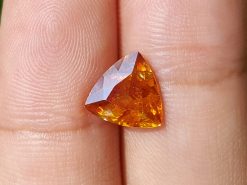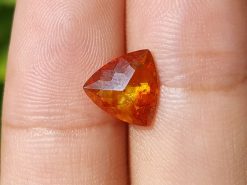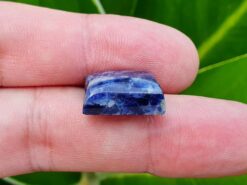Danburite

Danburite is a calcium boron silicate mineral with a chemical formula of CaB2(SiO4)2.
Buy natural gemstones in our gem shop
Danburite stone
Its name comes from Danbury, Connecticut, United States, where it was first discovered in 1839 by Charles Upham Shephard.
The stone can occur in a variety of colors ranging from colorless to very light-pink and from light-yellow to brown. But typically only colorless danburite is ever faceted as a gemstone.
It has a Mohs hardness of 7 to 7.5 and also a specific gravity of 3.0. The mineral has also an orthorhombic crystal form. It is usually colourless, like quartz, but can also be either pale yellow or yellowish-brown. It typically occurs in contact metamorphic rocks.
The Dana classification of minerals categorizes as a sorosilicate, while the Strunz classification scheme lists it as a tectosilicate. Both terms are correct.
Its crystal symmetry and form are similar to topaz; however, topaz is a calcium fluorine bearing nesosilicate. The clarity, resilience, and strong dispersion of danburite make it valuable as cut stones for jewelry.
Danburite crystal data
Orthorhombic. Crystals prismatic, rhomboidal.
Physical Properties
Cleavage: Indistinct on f001g.
Fracture: Uneven to subconchoidal.
Optical Properties
Transparent to translucent.
Color: Colorless, also white, wine-yellow, yellowish brown, greenish; colorless in thin section.
Streak: White.
Luster: Vitreous to greasy.
Occurrence
In granite and metamorphosed carbonate rocks associated with hydrothermal activity, in evaporites.
There is currently no example of treatment or enhancement for this stone. There are also no known synthetics or imitations available on the market.
Pink danburite
Colors typically range from colorless to light yellow, pale pink, or tan. With poor cleavage and a hardness of 7, it ranks with popular jewelry stones such as quartz and topaz in toughness. Although its modest dispersion means cut danburites lack fire, properly cut gems are very bright. The most reputed color is pink
Sources
The stone occurs in metamorphosed carbonate rocks and in granites associated with hydrothermal activity. It is also found in evaporites. The deposits of Danbury, Connecticut have long been covered over and made inaccessible due to the large community that has grown over the years.
Today, we can find sources in Japan, also Madagascar, Mexico, and Myanmar. Mexico is today’s most important source of gem-quality.
Danburite meaning and healing properties
Highly spiritual and sought after for its metaphysical properties, The stone is a powerful heart chakra stone, relieving emotional pain and increasing acceptance of one’s self and of others. The crystal will help you to “let your light shine”. The pure love energy of the crystal brings serenity and peace.
Danburite from Mexico
















